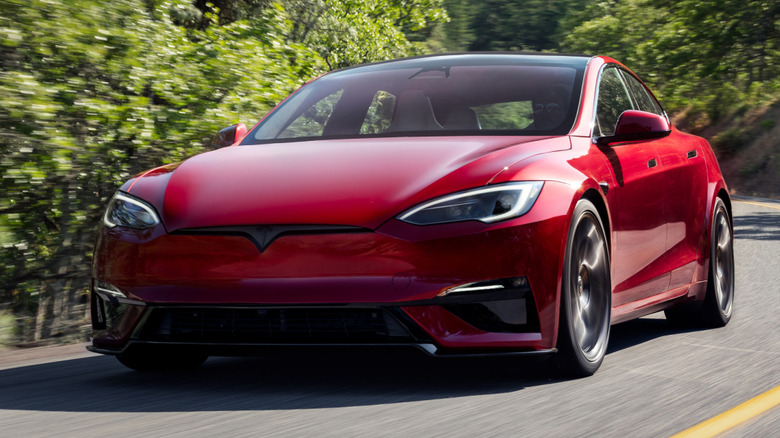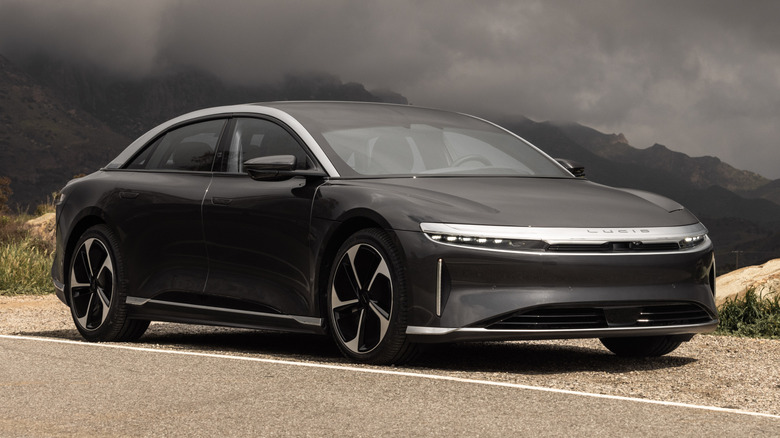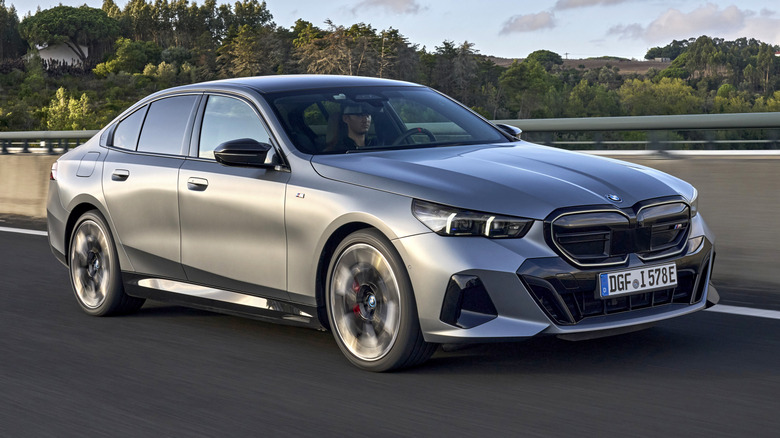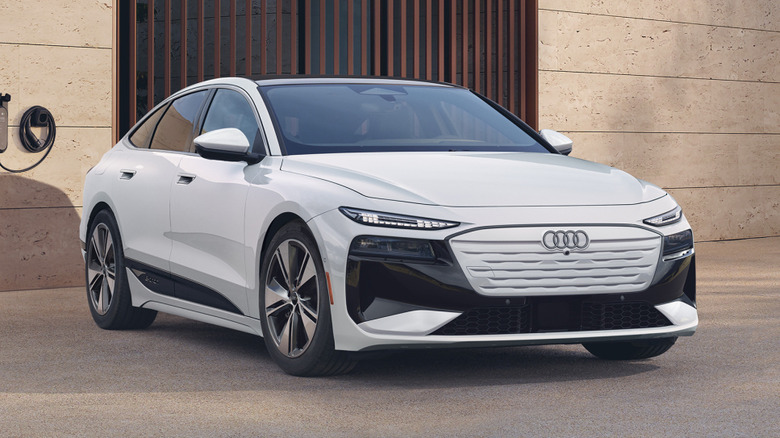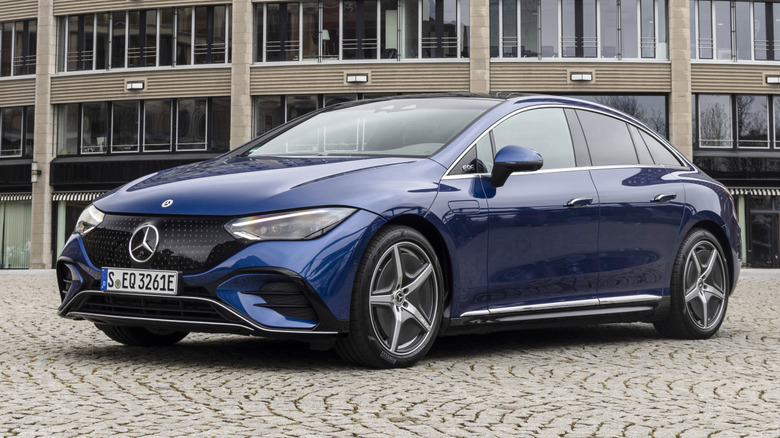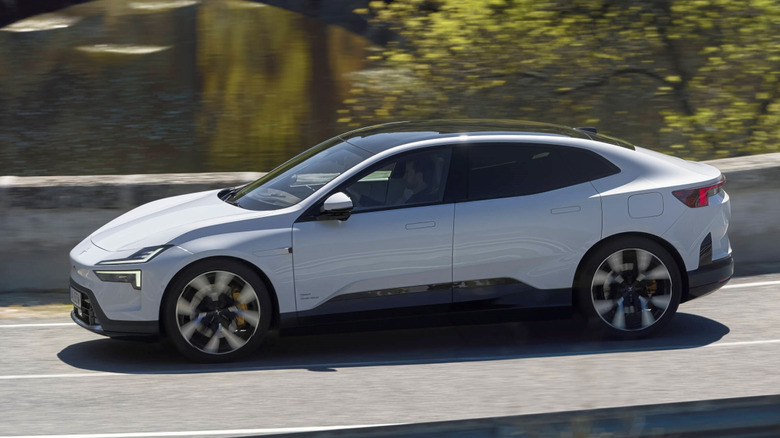5 Of The Best EV Alternatives To The Tesla Model S (And They're Cheaper, Too)
When the Tesla Model S launched back in 2012, it helped usher in a new era for the EV industry. Previously, EVs had relied on eco-friendliness as their only real selling point, but the Model S was a genuinely desirable car. It offered sizable real-world range, sleek looks, and a minimalist interior that proved hugely influential in shaping the design of today's EVs. However, the market has rapidly changed since then, and today the Model S is just one of a broad range of premium and luxury EVs buyers can pick from.
Despite the ever-increasing competition, the current Model S' spec sheet still looks impressive. The All-Wheel Drive variant offers 410 miles of range and sprints from 0-60 mph in 3.1 seconds, and at the time of writing, is available from $96,380 (including a $1,390 destination fee). It's certainly a lot of power for the cash, but today's luxury EV buyers demand more than simply straight-line speed. A number of rivals now offer a more well-rounded luxury experience, and these five in particular are also cheaper than the Model S to boot.
Lucid Air Touring
The only of the Model S' luxury rivals to offer greater range on a full charge, the Lucid Air is available in a variety of different trims spanning many price points. Arguably the best-value rival to the Model S All-Wheel Drive is the Air Touring, which starts from $81,400 (including a $1,500 destination fee). It delivers similar performance to the Tesla, with a 0-60 mph time of 3.4 seconds, and it can travel up to 431 miles on a single charge.
Buyers who aren't fussed about performance bragging rights could opt to save even more cash and choose the entry-level Air Pure trim, which starts from $72,400, including the destination fee. It's still very quick, with a 0-60 mph time of 4.5 seconds, and it still offers lots of standard equipment even without any option boxes ticked.
The Air Touring gets real leather upholstery throughout its cabin, while the Air Pure offers faux leather like the Model S. Much like the Tesla, the Lucid's controls are almost entirely screen-based, although unlike the Tesla, wireless Apple CarPlay is available as standard. After spending some time with the 2024 Air Pure, we found little to dislike about the car, giving it an Editor's Choice award at the time. Lucid's cars might remain a rare sight on the roads compared to many of their upscale competitors, but buyers would be doing themselves a disservice by overlooking them.
BMW i5 M60
The i5 is BMW's fully electric version of the 5-Series, although it still also offers hybrid and ICE versions of the car. The fastest model is the i5 M60, which can hit 60 mph from standstill in 3.7 seconds and starts from $85,275 (including a $1,175 destination fee).
We thought that the i5 was more responsive to drive than the Tesla Model S, having put the i5 to the test on the coastal roads of Portugal. It's also less barebones inside, with BMW's iDrive 8.5 infotainment system flanked by a pleasingly solid-feeling assortment of buttons and dials.
The biggest drawback of the i5 M60 is its range. At 253 miles, it is far less than the Model S and well below the segment average. For drivers looking for a luxurious, emissions-free commuter car, that might not be an issue, but it will likely be a dealbreaker for drivers who regularly go on longer road trips.
Audi A6/S6 Sportback e-tron
Audi launched its new electric Sportback sedan in two flavors, the base-spec A6 and sportier S6. While the S6 Sportback e-tron offers performance figures closer to that of the Tesla Model S, our reviewer wasn't convinced that most buyers would appreciate the upgraded performance. The S6 accelerates from 0-60 mph in 3.7 seconds, while the A6 needs 5.2 seconds to complete the same feat. However, the S6 has a shorter range compared to the A6 — 324 miles compared to the latter's 392 miles.
Both the S6 and A6 can be bought for less than the Tesla. The A6 is the cheapest, with a starting price of $67,195 (including a $1,295 destination fee) while the S6 costs $79,995. Both cars offer similarly confident handling, although we thought that the Audi's steering feel wasn't as sharp as rivals like the BMW i5. We also thought that the cabin materials in our review car felt cheap considering its starting price, a flaw that we wouldn't expect from an Audi. It's not a slam dunk success then, but the A6 and S6 Sportback e-tron still offer an appealing mix of performance and range, and would-be Tesla buyers shouldn't discount either of them.
Mercedes-Benz EQE Sedan
The inclusion of screens in a car to replace buttons and switches is a controversial topic among car buyers, but it's safe to assume that anyone who's considering buying a Tesla Model S is among the touchscreen faithful. In that case, the Mercedes-Benz EQE Sedan is well worth considering, even though it lacks the Hyperscreen that's available on the brand's priciest EVs. The EQE Sedan is still screen-heavy, with a 12.8-inch infotainment touchscreen and a 12.3-inch driver display.
While the Mercedes lacks the straight-line power of the Tesla, it's also considerably cheaper. It starts from $66,200 (including a $1,250 destination fee), although it's easy to bump up that final cost by indulging in the car's generous options list. It can complete the sprint from 0-60 mph in 5.8 seconds — not particularly remarkable by EV standards, but still more than enough to dart about in urban traffic. Its range is also down compared to the Tesla, at 308 miles, although it's still competitive with most of its segment rivals. Buyers looking to shave a few seconds off the 60 mph sprint could consider the AMG EQE Sedan, which hits 0-60 mph in 3.2 seconds, but they'll lose almost 90 miles of maximum range in the process.
Polestar 4
When the Polestar 5 sedan launches in the U.S. in 2026, it will rival the Model S, but it's expected to be both pricier and more luxurious than the Tesla. The Polestar 4 has already launched stateside, and it's arguably the brand's closest current Model S rival. Its unusual shape defies traditional classifications — it's often lumped in with SUVs and crossovers, but its side profile is closer to that of a hatchback.
The Polestar 4 controversially lacks a rear window, a deliberately divisive move that will either alienate potential buyers or draw them in with its weirdness. The upcoming 5 also lacks glass at the back, but the 3 SUV retains the more traditional windowed design. In single-motor guise, the car starts from $57,800 (including a $1,400 destination fee), making it far cheaper than the Model S.
However, it's also far slower off the line than the Tesla, taking 6.9 seconds to go from 0-60 mph. Opting for the dual motor variant closes that performance gap, allowing the 4 to hit the same speed in 3.7 seconds. It also adds to the cost, pushing its start price up to $64,300, and decreases the car's range to 280 miles. In comparison, the single-motor 4 manages 310 miles on a charge. Still, anyone who likes their EVs with a little added quirkiness and a healthy dose of minimalist Scandi luxury might find themselves won over by Polestar's oddest car.
